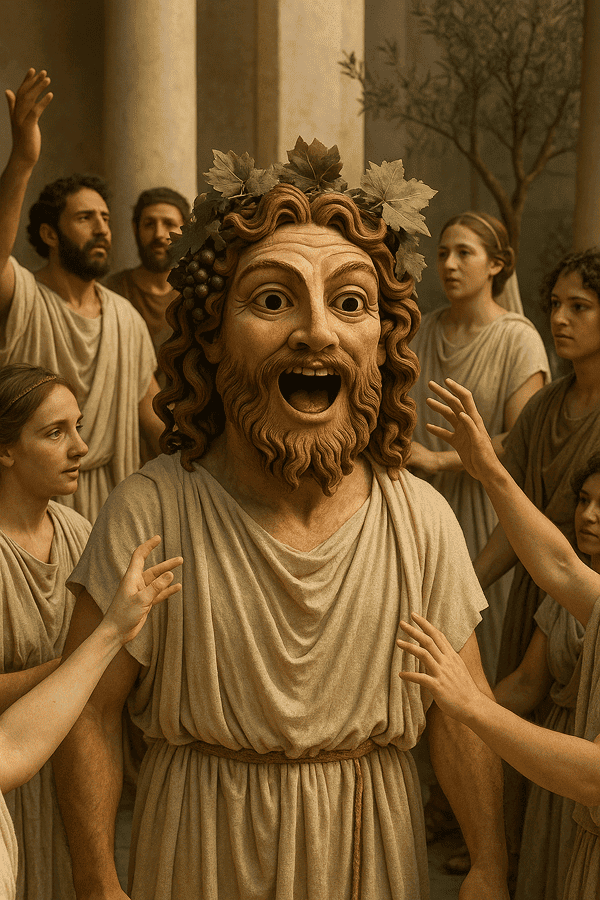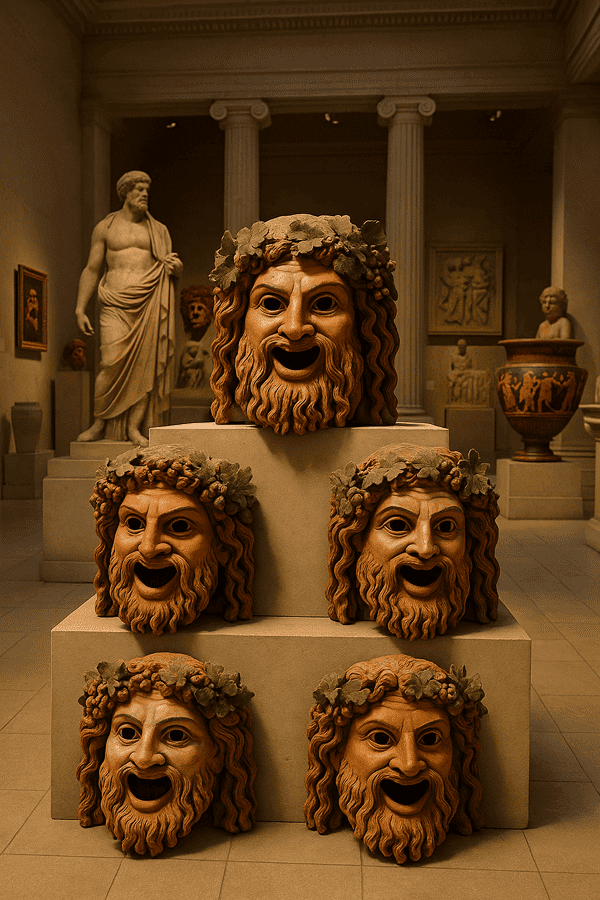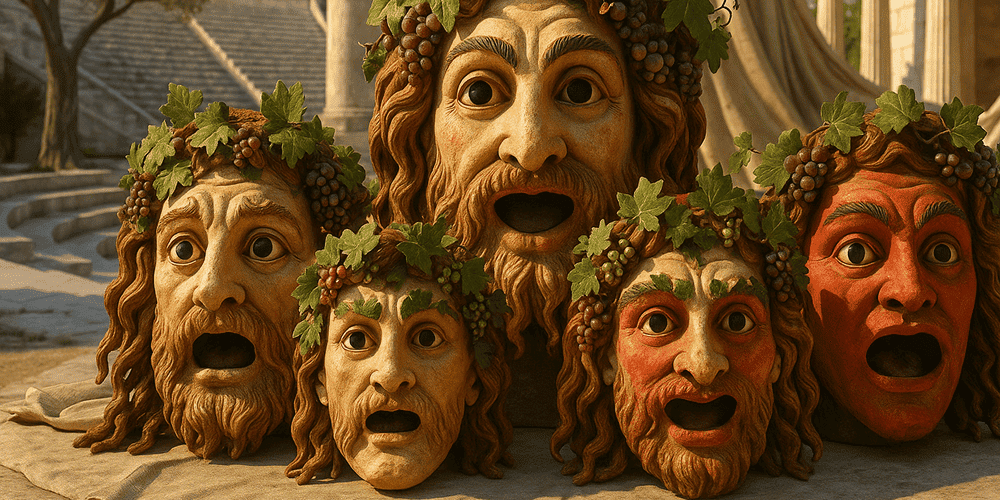Dionysus Masks are emblematic artifacts of ancient Greek culture, deeply tied to the origins of theatre, religious ritual, and artistic expression. These masks represent Dionysus, the god of wine, fertility, ecstasy, and dramatic arts. Dionysus Masks are instantly recognizable for their expressive, often ecstatic faces, wild hair or wreaths of ivy and grape leaves, and sometimes exaggerated features that capture the god’s dual nature of joy and frenzy. Typically crafted for use in religious festivals and theatrical performances, Dionysus Masks are rooted in the vibrant traditions of Attica, especially Athens, from as early as the 6th century BCE — the cradle of Western drama.
Historical Origins: The Origins and Evolution of Dionysus Masks
The story of Dionysus Masks begins in the archaic period of Greece, when masks were first used in Dionysian rituals and the earliest dramatic festivals. The name “Dionysus” comes from the Greek “Διόνυσος,” referring directly to the deity celebrated in these rites. Dionysus Masks were originally worn by priests and celebrants during processions, sacrifices, and ecstatic dances in honor of the god. As these rituals evolved into organized dramatic competitions — the famous Dionysia festivals — the masks became a central feature of Greek tragedy and comedy. Over centuries, the design of Dionysus Masks shifted from simple coverings to sophisticated, expressive works capable of conveying a wide spectrum of emotions. Archaeological finds, vase paintings, and ancient literary references provide evidence of their use and evolution. The development of Dionysus Masks is closely linked to the rise of Tragedy Masks, which became iconic symbols of Greek theatre.
Cultural Significance and Symbolism: Meaning of the Dionysus Mask
In Greek culture, Dionysus Masks held powerful religious, social, and artistic significance. They symbolized the presence of Dionysus himself, believed to inhabit the mask and possess the wearer during ritual performances. The mask’s ecstatic expression and wild adornments reflected the god’s association with transformation, liberation, and the breaking of conventional boundaries. Dionysus Masks were also seen as mediators between humans and the divine, enabling cathartic experiences and communal unity. Mythologically, Dionysus is the patron of theatre, and his mask embodies both the joyous and chaotic aspects of existence. Socially, the use of Dionysus Masks in festivals and theatre allowed citizens to explore themes of identity, fate, and morality in a collective setting.

Materials and Craftsmanship: Creating Dionysus Masks
Traditional Dionysus Masks were made from light, easily shaped materials such as linen, wood, leather, or clay. The crafting process began with molding the basic facial structure, followed by sculpting or layering to build expressive features — arched brows, open mouths, and wild hair or ivy wreaths. Artisans used natural pigments to paint the masks, often in vibrant colors like red, gold, and green, and added decorative elements such as grape clusters or ribbons. Tools included carving knives, chisels, and brushes. Regional workshops developed unique styles, with some masks featuring more abstract or stylized forms. The color palette and motifs were chosen to evoke the exuberance and sacredness of Dionysian celebrations.
Functions and Use: Dionysus Masks in Ritual and Performance
Dionysus Masks were central to both religious and theatrical life in ancient Greece. In Dionysian festivals, participants wore the masks during processions, sacrifices, and ecstatic dances, invoking the god’s presence and blessings. As the tradition of theatre emerged, Dionysus Masks became essential props in the performance of tragedy, comedy, and satyr plays. Actors wore the masks to assume the roles of gods, heroes, and ordinary people, projecting their voices and emotions to large audiences. The mask’s design allowed for both anonymity and transformation, blurring the line between actor and character. Over time, the use of Dionysus Masks expanded to include educational reenactments, artistic exhibitions, and modern revivals of ancient Greek drama.
Regional Variations: Diversity of Dionysus Masks
While Dionysus Masks originated in Attica, regional variations developed throughout the Greek world. In Athens, masks tended to be more refined and expressive, while in rural festivals they could be more primitive and exuberant. Some regions emphasized the god’s joyful side, with smiling faces and colorful garlands; others focused on his wild, frenzied aspect, using bold features and intense expressions. Comparisons with other ancient mask traditions, such as Roman and Etruscan theatre masks, reveal both shared roots and unique Greek innovations in form and symbolism.
Famous Examples and Collections: Where to See Dionysus Masks
Notable Dionysus Masks and related artifacts can be found in the National Archaeological Museum of Athens, the British Museum, and the Louvre. These collections include ancient terracotta masks, marble reliefs, vase paintings, and sculptures depicting Dionysian rituals. Archaeological finds from Greek theatres and sanctuaries also provide insight into the mask’s use and importance. Private collections and academic institutions house replicas and reconstructions for study and performance. For those interested in learning more, online platforms such as toddmasks.com provide curated galleries, educational articles, and resources on ancient masks.
Influence on Art and Culture: Dionysus Masks in Western Creativity
The influence of Dionysus Masks on Western art, theatre, and literature is immense. Their expressive forms have inspired playwrights, poets, painters, and modern performers for centuries. Dionysus Masks are referenced in works by Euripides, Sophocles, and Aristophanes, as well as in Roman and later European drama. In visual arts, the mask is a symbol of transformation, ecstasy, and artistic freedom. Contemporary theatre, opera, and film continue to draw on the legacy of Greek masks, using them to explore themes of identity, ritual, and catharsis. The connection to Tragedy Masks further highlights their central role in the heritage of dramatic storytelling.

Modern Status and Preservation: Keeping the Dionysus Mask Tradition Alive
Today, the tradition of Dionysus Mask-making and performance is preserved by artisans, theatre companies, and cultural institutions. Workshops, festivals, and academic programs teach traditional techniques and explore new artistic interpretations. Museums and universities document and exhibit ancient masks, while modern theatre groups stage revivals of Greek drama with authentic or contemporary masks. Educational initiatives and masterclasses encourage public engagement and appreciation, ensuring the ongoing vitality of this ancient tradition.
Collecting and Acquisition: The Market for Dionysus Masks
The market for Dionysus Masks includes archaeological artifacts, high-quality reproductions, and modern artistic interpretations. Authentic ancient masks are rare and typically housed in museums, while replicas and scholarly reconstructions are available for collectors, educators, and theatre practitioners. Prices depend on materials, craftsmanship, provenance, and historical value. Collectors should seek documentation, understand ethical considerations, and support the preservation of cultural heritage. Online resources like toddmasks.com offer guidance on authentic Dionysus Masks and responsible collecting practices.
